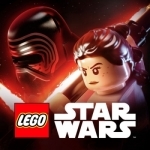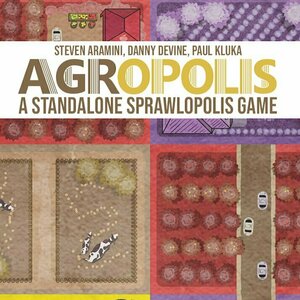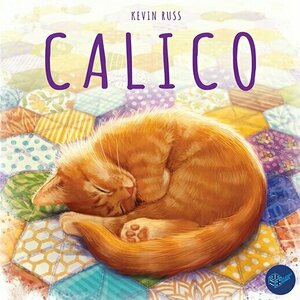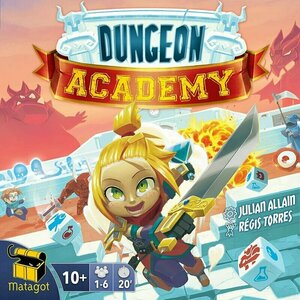Search

LEGO® Star Wars™: The Force Awakens
Games
App
**The first chapter of “The Force Awakens” story is free and additional levels, story, and...

Restless Minds by Ward Thomas
Album Watch
Following the release of their #1 album, ‘Cartwheels’ (2016), Ward Thomas return on scorching...
Purple Phoenix Games (2266 KP) rated Agropolis in Tabletop Games
Sep 24, 2020
Being based on the Iowa/Illinois border, Purple Phoenix Games is definitely headquartered in the good ol’ Midwest. We are not without cities and modern amenities, as some might suspect, but we are certainly accustomed to seeing farm life, rural communities, and rolling fields of crops. Figuring out how exactly to organize your fields and crops is no easy task, and Agropolis is here to put you to the test!
Disclaimer: We were provided a copy of Agropolis for the purposes of this preview. The components are not yet finalized, and will probably change from what you see here to the finished Kickstarter campaign. Agropolis is a stand-alone expansion to the popular ButtonShy title, Sprawlopolis. We have reviewed Sprawlopolis (as both a Solo Chronicles, as well as Multiplayer) in the past, so I do not intend to rehash the entire ruleset in this preview. -L
In Agropolis, players are working cooperatively to create a cohesive and thriving rural community. The overall gameplay is the same as Sprawlopolis, with a few thematic differences. To begin the game, randomly select 3 cards to dictate the scoring conditions for your specific game. Deal 1 card to each player (3 to the starting player), and place one card face-up in the center of the table. On your turn, you will draw a card, play a card into the communal countryside, pass your remaining cards to the next player, and then draw a new card. The goal is to create a countryside that scores enough points to surpass the combined total of the 3 scoring condition cards.
Each card is divided into four zones: cornfields, livestock pens, orchards, and vineyards. The selected scoring condition cards determine how you can earn and lose points for your card/zone placements in the countryside. That’s where strategy comes into play – you can’t just place your cards wherever you want! There has to be a method to the madness, and each placement must be carefully selected for maximum end-game points. When all cards have been played, tally up your points – earning points for each zone, gaining/losing points for scoring conditions, and deducting points for roads. If your final score is higher than the total of the 3 scoring conditions combined, then you have won!
As a big fan of Sprawlopolis, I am happy to report that ButtonShy has done it again with Agropolis. The overall gameplay and atmosphere is the same between both games, which adds a comfort and familiarity to the game, but the thematic differences and scoring conditions make the game feel subtly unique. Aside from a country theme, Agropolis has an optional challenge known as the Feed Fee. Certain cards have a feedbag and livestock symbol underneath the card’s score, and all cards have a combination of livestock symbols at the bottom of the scoring description. To play with the Feed Fee, simply count the number of that specific type of livestock across all 3 scoring condition cards and add that to your scoring total. You might even have multiple Feed Fees in play for a single game! That is a new added challenge unique to Agropolis, and can really up the ante of the gameplay.
Our preview copy of Agropolis also came with a 6-card combo pack expansion that allows you to combine both Agropolis and Sprawlopolis into one big game. To play with the combo pack, randomly select one scoring condition card from the three decks: Agropolis, Sprawlopolis, and the combo pack. Randomly select another combo pack card to be the starting card of your city/country blended community. On your turn, you will draw 1 Agropolis card and 1 Sprawlopolis card. Play only one of those cards to the tableau, and the other is discarded. When both draw decks run out, the game is over and points are tallied. This combo game is uniquely challenging because you have scoring conditions from both games. You can’t focus on the city-side and let the country peter out, because at least one of the scoring condition cards calls for a country-specific goal. This combo pack takes the simplicity of both games and really ups the amount of strategy required for success. Definitely a combo I will be playing a lot!
All in all, how is Agropolis? The gameplay itself is simple, strategic, and satisfying to play. Although nearly identical to Sprawlopolis, the thematic differences and country-specific scoring conditions make the game feel new and refreshing. I absolutely love the 6-card combo pack to combine both games together. It just heightens the gameplay and strategic considerations, and takes it from a smaller game to something with a little more heft. Some people are all about that city life, but I think Agropolis will show you the beauty of the rural community. Be sure to check out the Kickstarter campaign, going live on Tuesday, September 29th!
Disclaimer: We were provided a copy of Agropolis for the purposes of this preview. The components are not yet finalized, and will probably change from what you see here to the finished Kickstarter campaign. Agropolis is a stand-alone expansion to the popular ButtonShy title, Sprawlopolis. We have reviewed Sprawlopolis (as both a Solo Chronicles, as well as Multiplayer) in the past, so I do not intend to rehash the entire ruleset in this preview. -L
In Agropolis, players are working cooperatively to create a cohesive and thriving rural community. The overall gameplay is the same as Sprawlopolis, with a few thematic differences. To begin the game, randomly select 3 cards to dictate the scoring conditions for your specific game. Deal 1 card to each player (3 to the starting player), and place one card face-up in the center of the table. On your turn, you will draw a card, play a card into the communal countryside, pass your remaining cards to the next player, and then draw a new card. The goal is to create a countryside that scores enough points to surpass the combined total of the 3 scoring condition cards.
Each card is divided into four zones: cornfields, livestock pens, orchards, and vineyards. The selected scoring condition cards determine how you can earn and lose points for your card/zone placements in the countryside. That’s where strategy comes into play – you can’t just place your cards wherever you want! There has to be a method to the madness, and each placement must be carefully selected for maximum end-game points. When all cards have been played, tally up your points – earning points for each zone, gaining/losing points for scoring conditions, and deducting points for roads. If your final score is higher than the total of the 3 scoring conditions combined, then you have won!
As a big fan of Sprawlopolis, I am happy to report that ButtonShy has done it again with Agropolis. The overall gameplay and atmosphere is the same between both games, which adds a comfort and familiarity to the game, but the thematic differences and scoring conditions make the game feel subtly unique. Aside from a country theme, Agropolis has an optional challenge known as the Feed Fee. Certain cards have a feedbag and livestock symbol underneath the card’s score, and all cards have a combination of livestock symbols at the bottom of the scoring description. To play with the Feed Fee, simply count the number of that specific type of livestock across all 3 scoring condition cards and add that to your scoring total. You might even have multiple Feed Fees in play for a single game! That is a new added challenge unique to Agropolis, and can really up the ante of the gameplay.
Our preview copy of Agropolis also came with a 6-card combo pack expansion that allows you to combine both Agropolis and Sprawlopolis into one big game. To play with the combo pack, randomly select one scoring condition card from the three decks: Agropolis, Sprawlopolis, and the combo pack. Randomly select another combo pack card to be the starting card of your city/country blended community. On your turn, you will draw 1 Agropolis card and 1 Sprawlopolis card. Play only one of those cards to the tableau, and the other is discarded. When both draw decks run out, the game is over and points are tallied. This combo game is uniquely challenging because you have scoring conditions from both games. You can’t focus on the city-side and let the country peter out, because at least one of the scoring condition cards calls for a country-specific goal. This combo pack takes the simplicity of both games and really ups the amount of strategy required for success. Definitely a combo I will be playing a lot!
All in all, how is Agropolis? The gameplay itself is simple, strategic, and satisfying to play. Although nearly identical to Sprawlopolis, the thematic differences and country-specific scoring conditions make the game feel new and refreshing. I absolutely love the 6-card combo pack to combine both games together. It just heightens the gameplay and strategic considerations, and takes it from a smaller game to something with a little more heft. Some people are all about that city life, but I think Agropolis will show you the beauty of the rural community. Be sure to check out the Kickstarter campaign, going live on Tuesday, September 29th!
Purple Phoenix Games (2266 KP) rated Calico in Tabletop Games
Oct 3, 2019
Cats. You love them. I tolerate them. I’m a dog person. While cats are the first things I think of when I hear the word Calico, it actually is also referencing a printed pattern. In this case, Calico refers to the printed fabrics to be woven into a quilt as well as the fluffy and mostly-indifferent mammalian species. Let’s take a closer look at Calico.
Calico is a game of tile drafting, tile placement, pattern recognition, with a hint of point salad. Now, not everything you do will score you points, but there are many ways to score. This game plays equally well solo as it does with a group, but how does one play it?
DISCLAIMER: We were provided a prototype copy of this game for the purposes of this review. As this is a preview copy of the game, I do not know if the final rules or components will be similar or different to what we were provided. -T
To setup, each player chooses a quilt board that has a different colored stitching printed on it. This is the player’s color. Each player will receive their goal tiles of matching color and choose three of these to place on their boards in the starting positions (the rule book also details a recommended first game placement and tile choice). These tiles show the requirements to score them and how many points each scoring tile is worth. Three cat placards are chosen that will be visiting your quilt sections and who score differently from each other. Place the corresponding cat tokens nearby and randomly assign two black-and-white patter tokens to each cat under their placard. Place the cute rainbow tile and matching button tokens nearby. Shuffle the quilt patch tiles and place them in a pile or stack at the middle of the table. From this collection deal two per player, and draw and reveal three more face up to be the offer row. You are now ready to play.
On your turn you will place a tile from your hand, check for scoring, and then draw a new patch tile to your hand. You may place either of your tiles anywhere on your board in any orientation you like. Complete freedom! In order to score points, however, you will want to be strategic in where tiles are placed. You see, the scoring tiles you placed at setup will dictate how they score. Some tiles score when you have two sets of three similar tiles. Tiles are similar either by matching their patterns or their tile colors. Some tiles score when you have placed NO matches at all. Each of these tiles will score points based on whether you satisfied its requirements by color, by shape, or both. Example: a scoring tile says AAA-BBB. This means it wants two sets of three matching patch tiles surrounding it – and ONLY the tiles surrounding it. It also has printed scores of 8 and 13. This means that if you have two sets of tiles that match by color only (but not pattern) you will score 8 points. Should you match three tiles’ colors but also match three tiles’ patterns you will score 13 points.
It is important to note here that the six tiles surrounding the score tile do not have to match exactly. So you do not have to have three yellow tiles with ivy pattern. You need to have three yellow tiles (if you chose yellow for this example) and three tiles that have the ivy pattern. Your other set can be three blue tiles with three stripes patterns. As long as you have these sets from the six surrounding tiles you will score what is on that tile.
The cats come into play when you satisfy their scoring requirement printed on their placard. So Thimble, the actual Calico cat, will visit a portion of your quilt when you have placed three tiles adjacent to each other with their preferred pattern. In the example shown Thimble likes ferns and polka dots. So whenever you have three or more connecting tiles that share one of these patterns you will grab a Thimble token and place it on one of the tiles on your board. Each cat will have different scoring requirements and patterns of which to be aware.
Similarly, but with colors, are the rainbow scoring button tokens. Each patch tile contains a color and a pattern. Cats are attracted to patterns, whereas buttons are sewn onto similar colored tiles. Match up three tiles of the same color and you can sew a button onto your quilt. Buttons are worth 3 points and they just look great on your quilt.
Play continues in this fashion until all quilts are completed. Players then tally up their scores and determine the winner of Calico!
Components. Again, we were provided a prototype of this game, so I will not comment too much on the components as they will probably change from now until production. But, I am able to comment on the art and visual aspects. The art is by Beth Sobel. Do I need to say more at this point? Yes? Ok. So the illustrations of the cats are wonderful. The sleepy little space heaters are depicted so well and they really are cute (I mean, if you’re into cats). The patterns and colors on the quilt tiles and buttons are absolutely fantastic. Just seeing it on the table makes me excited to play it, and for a game about quilts and cats that is REALLY saying something. The art and visual appeal of this game is truly off the charts.
I am not colorblind, but I do appreciate when designers consider options for gamers who are. In Calico, though you are playing for and concentrating on patterns and colors, the tiles are also printed with icons that match the shapes of the buttons to be claimed. As you can see in our photos, yellow tiles have a crescent moon, which match the crescent moon button you claim. The purple tiles have a ghost? Onion? Jawless skull? Blueberry? Whatever it is, it also matched the token you claim for the rainbow bonus points. I like this. I like this a lot.
So do we like playing it? I have played several games of this solo as well as with a group, and it truly is fantastic. It’s one of those games that you can go nutty trying to figure out the optimal play, or you can just play it casually to come up with the prettiest end result. Granted, you probably will not win much, but golly look at your quilt! You can play Calico with ANY gamer type: beginner, casual, hard core, and industry personalities. And I believe that every one who plays this will have a great time and salivate for more plays (cats salivate, right? Or is that a dog-only thing?). I am very excited to see what Flatout Games has in store for this one on Kickstarter, and I would be happy to play with anyone who asks, or as part of anyone’s gaming event.
Calico is a game of tile drafting, tile placement, pattern recognition, with a hint of point salad. Now, not everything you do will score you points, but there are many ways to score. This game plays equally well solo as it does with a group, but how does one play it?
DISCLAIMER: We were provided a prototype copy of this game for the purposes of this review. As this is a preview copy of the game, I do not know if the final rules or components will be similar or different to what we were provided. -T
To setup, each player chooses a quilt board that has a different colored stitching printed on it. This is the player’s color. Each player will receive their goal tiles of matching color and choose three of these to place on their boards in the starting positions (the rule book also details a recommended first game placement and tile choice). These tiles show the requirements to score them and how many points each scoring tile is worth. Three cat placards are chosen that will be visiting your quilt sections and who score differently from each other. Place the corresponding cat tokens nearby and randomly assign two black-and-white patter tokens to each cat under their placard. Place the cute rainbow tile and matching button tokens nearby. Shuffle the quilt patch tiles and place them in a pile or stack at the middle of the table. From this collection deal two per player, and draw and reveal three more face up to be the offer row. You are now ready to play.
On your turn you will place a tile from your hand, check for scoring, and then draw a new patch tile to your hand. You may place either of your tiles anywhere on your board in any orientation you like. Complete freedom! In order to score points, however, you will want to be strategic in where tiles are placed. You see, the scoring tiles you placed at setup will dictate how they score. Some tiles score when you have two sets of three similar tiles. Tiles are similar either by matching their patterns or their tile colors. Some tiles score when you have placed NO matches at all. Each of these tiles will score points based on whether you satisfied its requirements by color, by shape, or both. Example: a scoring tile says AAA-BBB. This means it wants two sets of three matching patch tiles surrounding it – and ONLY the tiles surrounding it. It also has printed scores of 8 and 13. This means that if you have two sets of tiles that match by color only (but not pattern) you will score 8 points. Should you match three tiles’ colors but also match three tiles’ patterns you will score 13 points.
It is important to note here that the six tiles surrounding the score tile do not have to match exactly. So you do not have to have three yellow tiles with ivy pattern. You need to have three yellow tiles (if you chose yellow for this example) and three tiles that have the ivy pattern. Your other set can be three blue tiles with three stripes patterns. As long as you have these sets from the six surrounding tiles you will score what is on that tile.
The cats come into play when you satisfy their scoring requirement printed on their placard. So Thimble, the actual Calico cat, will visit a portion of your quilt when you have placed three tiles adjacent to each other with their preferred pattern. In the example shown Thimble likes ferns and polka dots. So whenever you have three or more connecting tiles that share one of these patterns you will grab a Thimble token and place it on one of the tiles on your board. Each cat will have different scoring requirements and patterns of which to be aware.
Similarly, but with colors, are the rainbow scoring button tokens. Each patch tile contains a color and a pattern. Cats are attracted to patterns, whereas buttons are sewn onto similar colored tiles. Match up three tiles of the same color and you can sew a button onto your quilt. Buttons are worth 3 points and they just look great on your quilt.
Play continues in this fashion until all quilts are completed. Players then tally up their scores and determine the winner of Calico!
Components. Again, we were provided a prototype of this game, so I will not comment too much on the components as they will probably change from now until production. But, I am able to comment on the art and visual aspects. The art is by Beth Sobel. Do I need to say more at this point? Yes? Ok. So the illustrations of the cats are wonderful. The sleepy little space heaters are depicted so well and they really are cute (I mean, if you’re into cats). The patterns and colors on the quilt tiles and buttons are absolutely fantastic. Just seeing it on the table makes me excited to play it, and for a game about quilts and cats that is REALLY saying something. The art and visual appeal of this game is truly off the charts.
I am not colorblind, but I do appreciate when designers consider options for gamers who are. In Calico, though you are playing for and concentrating on patterns and colors, the tiles are also printed with icons that match the shapes of the buttons to be claimed. As you can see in our photos, yellow tiles have a crescent moon, which match the crescent moon button you claim. The purple tiles have a ghost? Onion? Jawless skull? Blueberry? Whatever it is, it also matched the token you claim for the rainbow bonus points. I like this. I like this a lot.
So do we like playing it? I have played several games of this solo as well as with a group, and it truly is fantastic. It’s one of those games that you can go nutty trying to figure out the optimal play, or you can just play it casually to come up with the prettiest end result. Granted, you probably will not win much, but golly look at your quilt! You can play Calico with ANY gamer type: beginner, casual, hard core, and industry personalities. And I believe that every one who plays this will have a great time and salivate for more plays (cats salivate, right? Or is that a dog-only thing?). I am very excited to see what Flatout Games has in store for this one on Kickstarter, and I would be happy to play with anyone who asks, or as part of anyone’s gaming event.
Purple Phoenix Games (2266 KP) rated Dungeon Academy in Tabletop Games
Dec 8, 2020
Roll-and-write style games have come a really long way over the past couple years. In the olden days we had Yahtzee, and that satisfied us. But then designers began dusting off that olde mechanic and breathing new life into it. While roll-and-write may never become my favorite mechanic, I am starting to appreciate the good ones more and more each time I play them. Dungeon Academy is one of these good games.
In Dungeon Academy players are taking the roles of students attempting their finals to become graduated warriors and mages in the land. They must pass their tests though, and that entails surviving through the dreaded Dungeon four times and surpassing all opponents to receive their degree.
DISCLAIMER: We were provided a copy of this game for the purposes of this review. This is a retail copy of the game, so what you see in these photos is exactly what would be received in your box. I do not intend to cover every single rule included in the rulebook, but will describe the overall game flow and major rule set so that our readers may get a sense of how the game plays. For more in depth rules, you may purchase a copy online or from your FLGS. -T
To setup a solo game of Dungeon Academy, assemble the Dungeon component per the instructions. The player is dealt a character card with a special ability and markers to track Health and Mana throughout the game. Pile the Health and Mana tokens on the table, shuffle the Loot cards into a deck, and place the Teacher pawn nearby. Grab the pad of paper and pen and you are ready to begin.
Each attempt in the Dungeon will require the 16 Base Dice to be rolled and set inside the Dungeon. It is then flipped upside down when the timer begins and the mad dash to the Exit commences. As the player marks a line through every “room” (each die is considered a “room” in the Dungeon) they create a path to be checked at the end of the round. Once the player has made it through the Dungeon satisfactorily the Teacher will check the path.
The Teacher pawn is now used to track movement in the Dungeon. As the player tracks the path they drew on the paper, the Teacher is moved through the rooms. In each room (each die face) will be one of these possible encounters: a Mana potion to refill an empty Mana space on the character card, a Health potion, a small red Blob, a small blue Ghost, a large red Colossus, or a large blue Reaper. Each small foe encountered will be overtaken by spending one Health or Mana token from the character card. Each potion will restore spent Health or Mana. Each large foe encountered will require two Health or Mana to be spent. As the Teacher follows the path set by the player, Health and Mana will be spent and replenished on the character card, and foes defeated tracked on the sheet.
Once complete, the player will add up all the points from defeated foes (1VP per foe) and any VP from special character abilities or Loot cards. Additionally, the player will choose one of the four Quests at the bottom of the sheet to score each round for extra VP. They write these numbers on the sheet and prepare for the next level. After four total levels the game ends and the total is compared to a scale in the rulebook.
Multiplayer Dungeon Academy works the exact same way except once a player exits the Dungeon, they must grab the lowest-numbered Exit card as representation of the place finished in the Dungeon (so the first one out grabs the 1 card, etc.). The other difference from solo play is that players all compare total VP at the game end to determine the winner.
Components. This game has a large scorepad of 150 double-sided sheets, a bunch of cards for Hero characters, Loot, and Exits, as well as 18 total dice, about a trillion double-sided Health/Mana tokens and an impressive cardboard Dungeon. Everything is of wonderful Matagot quality… except for the Duneon. In my copy the Dungeon does not stay together very well. I may attempt some glue to keep the parts down that need to stay down, but it is still functional and a great design. The art style across the game is cute and fun, and I like the muted bright color scheme. That feels so weird to say/type, but the colors are vibrant hues, but muted so they stay out of the way. It’s strange and I love it.
Speaking of I love it, I love this game! It is quickly becoming one of my favorite roll-and-write games, and I can play it solo. In about 15 minutes. These are all positives, and I haven’t even really touched on the gameplay. Being able to get through a light solo game in 15 minutes while having a great time throughout is an achievement, and one I would like to applaud here. I wasn’t really sure going into this if I was going to enjoy it, but it has blown me away. Trying to evaluate the best path through the Dungeon while keeping track of how the Health and Mana is always in flux gives my brain a welcomed workout that is just a breath of fresh air for me. I love the art style and the theme, and the simple but easy to understand iconography on the dice is much appreciated.
I think that if you are looking for or lacking a similar type game in your collection you should do yourself a favor and check out Dungeon Academy. It is super quick, easy to grasp and play, requires little table space, and is simply a great time alone or with your gamer friends and family. I know I am going to be tracking lots of plays with this one. I am going to have to find a place on my shelves at eye-level because I don’t want it to be overshadowed down at foot-level.
If you already enjoy roll-and-write games and want something a little different with a great theme, or you don’t have any roll-and-writes and want to check one out for the first time, or you simply cannot get enough games featuring great art about wizards in school check this one out. I recommend it.
In Dungeon Academy players are taking the roles of students attempting their finals to become graduated warriors and mages in the land. They must pass their tests though, and that entails surviving through the dreaded Dungeon four times and surpassing all opponents to receive their degree.
DISCLAIMER: We were provided a copy of this game for the purposes of this review. This is a retail copy of the game, so what you see in these photos is exactly what would be received in your box. I do not intend to cover every single rule included in the rulebook, but will describe the overall game flow and major rule set so that our readers may get a sense of how the game plays. For more in depth rules, you may purchase a copy online or from your FLGS. -T
To setup a solo game of Dungeon Academy, assemble the Dungeon component per the instructions. The player is dealt a character card with a special ability and markers to track Health and Mana throughout the game. Pile the Health and Mana tokens on the table, shuffle the Loot cards into a deck, and place the Teacher pawn nearby. Grab the pad of paper and pen and you are ready to begin.
Each attempt in the Dungeon will require the 16 Base Dice to be rolled and set inside the Dungeon. It is then flipped upside down when the timer begins and the mad dash to the Exit commences. As the player marks a line through every “room” (each die is considered a “room” in the Dungeon) they create a path to be checked at the end of the round. Once the player has made it through the Dungeon satisfactorily the Teacher will check the path.
The Teacher pawn is now used to track movement in the Dungeon. As the player tracks the path they drew on the paper, the Teacher is moved through the rooms. In each room (each die face) will be one of these possible encounters: a Mana potion to refill an empty Mana space on the character card, a Health potion, a small red Blob, a small blue Ghost, a large red Colossus, or a large blue Reaper. Each small foe encountered will be overtaken by spending one Health or Mana token from the character card. Each potion will restore spent Health or Mana. Each large foe encountered will require two Health or Mana to be spent. As the Teacher follows the path set by the player, Health and Mana will be spent and replenished on the character card, and foes defeated tracked on the sheet.
Once complete, the player will add up all the points from defeated foes (1VP per foe) and any VP from special character abilities or Loot cards. Additionally, the player will choose one of the four Quests at the bottom of the sheet to score each round for extra VP. They write these numbers on the sheet and prepare for the next level. After four total levels the game ends and the total is compared to a scale in the rulebook.
Multiplayer Dungeon Academy works the exact same way except once a player exits the Dungeon, they must grab the lowest-numbered Exit card as representation of the place finished in the Dungeon (so the first one out grabs the 1 card, etc.). The other difference from solo play is that players all compare total VP at the game end to determine the winner.
Components. This game has a large scorepad of 150 double-sided sheets, a bunch of cards for Hero characters, Loot, and Exits, as well as 18 total dice, about a trillion double-sided Health/Mana tokens and an impressive cardboard Dungeon. Everything is of wonderful Matagot quality… except for the Duneon. In my copy the Dungeon does not stay together very well. I may attempt some glue to keep the parts down that need to stay down, but it is still functional and a great design. The art style across the game is cute and fun, and I like the muted bright color scheme. That feels so weird to say/type, but the colors are vibrant hues, but muted so they stay out of the way. It’s strange and I love it.
Speaking of I love it, I love this game! It is quickly becoming one of my favorite roll-and-write games, and I can play it solo. In about 15 minutes. These are all positives, and I haven’t even really touched on the gameplay. Being able to get through a light solo game in 15 minutes while having a great time throughout is an achievement, and one I would like to applaud here. I wasn’t really sure going into this if I was going to enjoy it, but it has blown me away. Trying to evaluate the best path through the Dungeon while keeping track of how the Health and Mana is always in flux gives my brain a welcomed workout that is just a breath of fresh air for me. I love the art style and the theme, and the simple but easy to understand iconography on the dice is much appreciated.
I think that if you are looking for or lacking a similar type game in your collection you should do yourself a favor and check out Dungeon Academy. It is super quick, easy to grasp and play, requires little table space, and is simply a great time alone or with your gamer friends and family. I know I am going to be tracking lots of plays with this one. I am going to have to find a place on my shelves at eye-level because I don’t want it to be overshadowed down at foot-level.
If you already enjoy roll-and-write games and want something a little different with a great theme, or you don’t have any roll-and-writes and want to check one out for the first time, or you simply cannot get enough games featuring great art about wizards in school check this one out. I recommend it.

Blackbox Live for Dreambox and Vu+ (formerly Dreambox LIVE)
Entertainment and Utilities
App
Enjoy live TV directly on your iPad, iPhone or iPod Touch from your Dreambox, Vu+ or any other...
Purple Phoenix Games (2266 KP) rated Belfort in Tabletop Games
Jun 10, 2021
I don’t know if I have ever just come out and said it before, but I love worker placement games. I just adore the mechanic and if a game includes it, the chances of me liking it are quite good. Belfort is an older game now (almost 10 years old!) so does it still excite and deliver the goods when so many other great worker placement games have been produced since it debuted?
The winner of Belfort is the player who, at the end of seven rounds of play, earns the most Victory Points (VP). Players will earn victory points by having majority of buildings claimed within the five districts of Belfort. To claim a building, players will be shrewdly sending workers to mines, the forest, and various buildings and guilds of Belfort to recruit more workers and earn the ever-important buck to finance these buildings.
Setup is kind of a beast, so I won’t detail everything here. Similarly, I will not be detailing every rule in the book, as there are just too many. But, I will give a general flow of the game so readers may be able to decide if this is a game they must add to their collections.
Once the game is setup and player order is established, each player will complete their entire turn in player order. Players will have many choices available to them on their turn: place workers on various buildings they had previously built, place workers on guild tiles to access powerful abilities, recruit more workers, hire gnomes to unlock certain portions of buildings, gaining more building plans, visiting the trading post to exchange resources, transform normal workers into master workers, and lastly assign workers to gather resources (wood, stone, metal, and gold) in the forests and mines surrounding Belfort.
At certain times during the game players will score their efforts to move up (and down) the VP track. It is at the end of the third and final scoring that the game ends and a victor is crowned.
While this is a very broad and general description of the rules of Belfort, each option listed contains layers of strategic depth that, like all good worker placement games, limits the players’ abilities to go everywhere they like as workers are in limited supply. For those gamers who have never played a worker placement game, this is both excruciating and delicious.
Components. This game boasts way too many components for the box in which is barely contained. I say this with one complete expansion and the promo set of guild tiles included, and the latest expansion on the way. All of the components in this game are stellar. The cards are great. All the cardboard play mats and tiles are great. The worker components and all the wooden bits are super great, AND I didn’t even mind having to sticker my own workers. The best part about the components in Belfort is definitely the art. The team designed an excellent art style for this one, and seeing little hidden jokes within the art makes it all that more interesting to me.
So DOES it hold up after all these years? I think it does. Though I would not consider Belfort an “easy” game to learn, teach, or play at first, after a few rounds players generally catch on and begin to really weigh all their options. This is a great game for think-hungry gamers. This game is conversely a bane for all AP-prone players. I fall right in the middle, but lean towards faster play at the expense of my final score. But that’s the beauty of Belfort and of all worker placement games: there are so many choices that one could easily just try to play so that they visit every location at least once. Now, by doing this the players are also ignoring the true goal of the game: area majority within the districts of Belfort, but if a player isn’t as aggressive or victory-crazed, that’s not a bad thing.
For me, I love Belfort. A lot. Unfortunately for me, during this crazy COVID time, I will not be able to play it much, and was lucky to be able to pull it out recently again after not playing it for several years. But, I always look upon the box fondly and wish I could just bust it out any time I want. Maybe someday someone will create solo rules for it and I can enjoy it that way. My wife is not a fan, but also she’s not really a fan of games that are longer than an hour generally. I cherish this game, and am quite happy to have it in my collection.
The winner of Belfort is the player who, at the end of seven rounds of play, earns the most Victory Points (VP). Players will earn victory points by having majority of buildings claimed within the five districts of Belfort. To claim a building, players will be shrewdly sending workers to mines, the forest, and various buildings and guilds of Belfort to recruit more workers and earn the ever-important buck to finance these buildings.
Setup is kind of a beast, so I won’t detail everything here. Similarly, I will not be detailing every rule in the book, as there are just too many. But, I will give a general flow of the game so readers may be able to decide if this is a game they must add to their collections.
Once the game is setup and player order is established, each player will complete their entire turn in player order. Players will have many choices available to them on their turn: place workers on various buildings they had previously built, place workers on guild tiles to access powerful abilities, recruit more workers, hire gnomes to unlock certain portions of buildings, gaining more building plans, visiting the trading post to exchange resources, transform normal workers into master workers, and lastly assign workers to gather resources (wood, stone, metal, and gold) in the forests and mines surrounding Belfort.
At certain times during the game players will score their efforts to move up (and down) the VP track. It is at the end of the third and final scoring that the game ends and a victor is crowned.
While this is a very broad and general description of the rules of Belfort, each option listed contains layers of strategic depth that, like all good worker placement games, limits the players’ abilities to go everywhere they like as workers are in limited supply. For those gamers who have never played a worker placement game, this is both excruciating and delicious.
Components. This game boasts way too many components for the box in which is barely contained. I say this with one complete expansion and the promo set of guild tiles included, and the latest expansion on the way. All of the components in this game are stellar. The cards are great. All the cardboard play mats and tiles are great. The worker components and all the wooden bits are super great, AND I didn’t even mind having to sticker my own workers. The best part about the components in Belfort is definitely the art. The team designed an excellent art style for this one, and seeing little hidden jokes within the art makes it all that more interesting to me.
So DOES it hold up after all these years? I think it does. Though I would not consider Belfort an “easy” game to learn, teach, or play at first, after a few rounds players generally catch on and begin to really weigh all their options. This is a great game for think-hungry gamers. This game is conversely a bane for all AP-prone players. I fall right in the middle, but lean towards faster play at the expense of my final score. But that’s the beauty of Belfort and of all worker placement games: there are so many choices that one could easily just try to play so that they visit every location at least once. Now, by doing this the players are also ignoring the true goal of the game: area majority within the districts of Belfort, but if a player isn’t as aggressive or victory-crazed, that’s not a bad thing.
For me, I love Belfort. A lot. Unfortunately for me, during this crazy COVID time, I will not be able to play it much, and was lucky to be able to pull it out recently again after not playing it for several years. But, I always look upon the box fondly and wish I could just bust it out any time I want. Maybe someday someone will create solo rules for it and I can enjoy it that way. My wife is not a fan, but also she’s not really a fan of games that are longer than an hour generally. I cherish this game, and am quite happy to have it in my collection.

Guitar Jam Tracks : Reggae
Music and Entertainment
App
MAKES LEARNING GUITAR FUN Practice jamming, learning scales and soloing to a Reggae jam track in...





